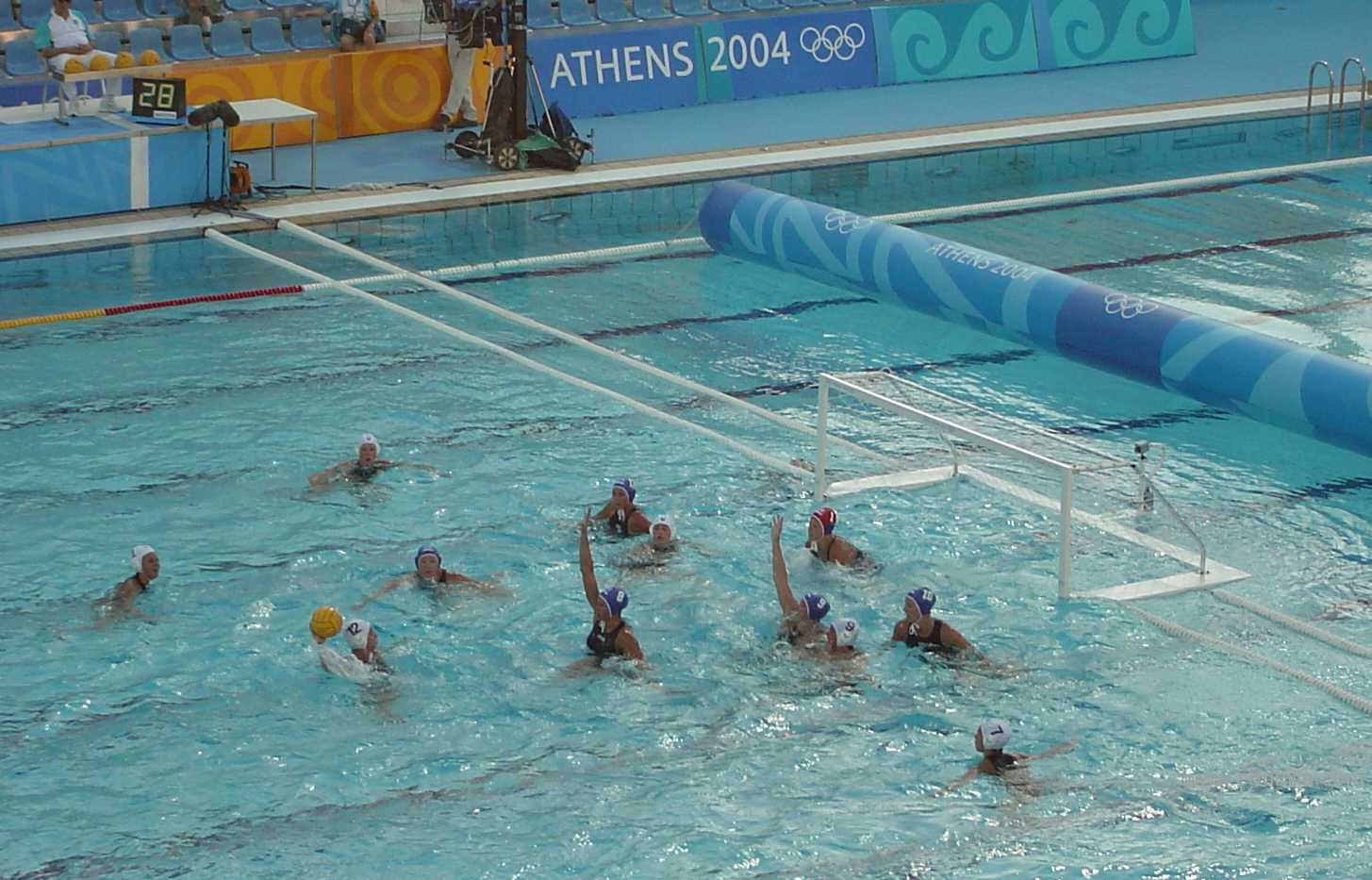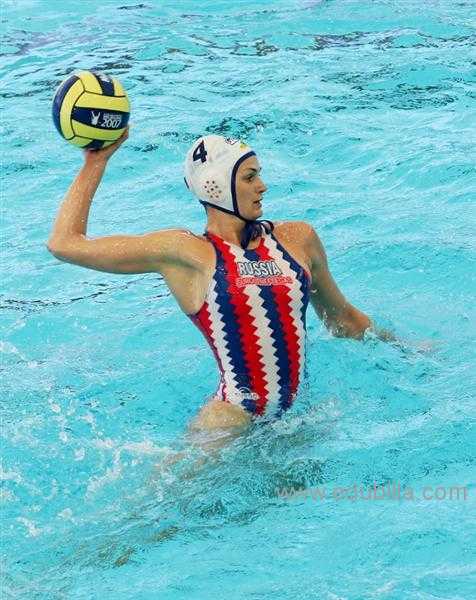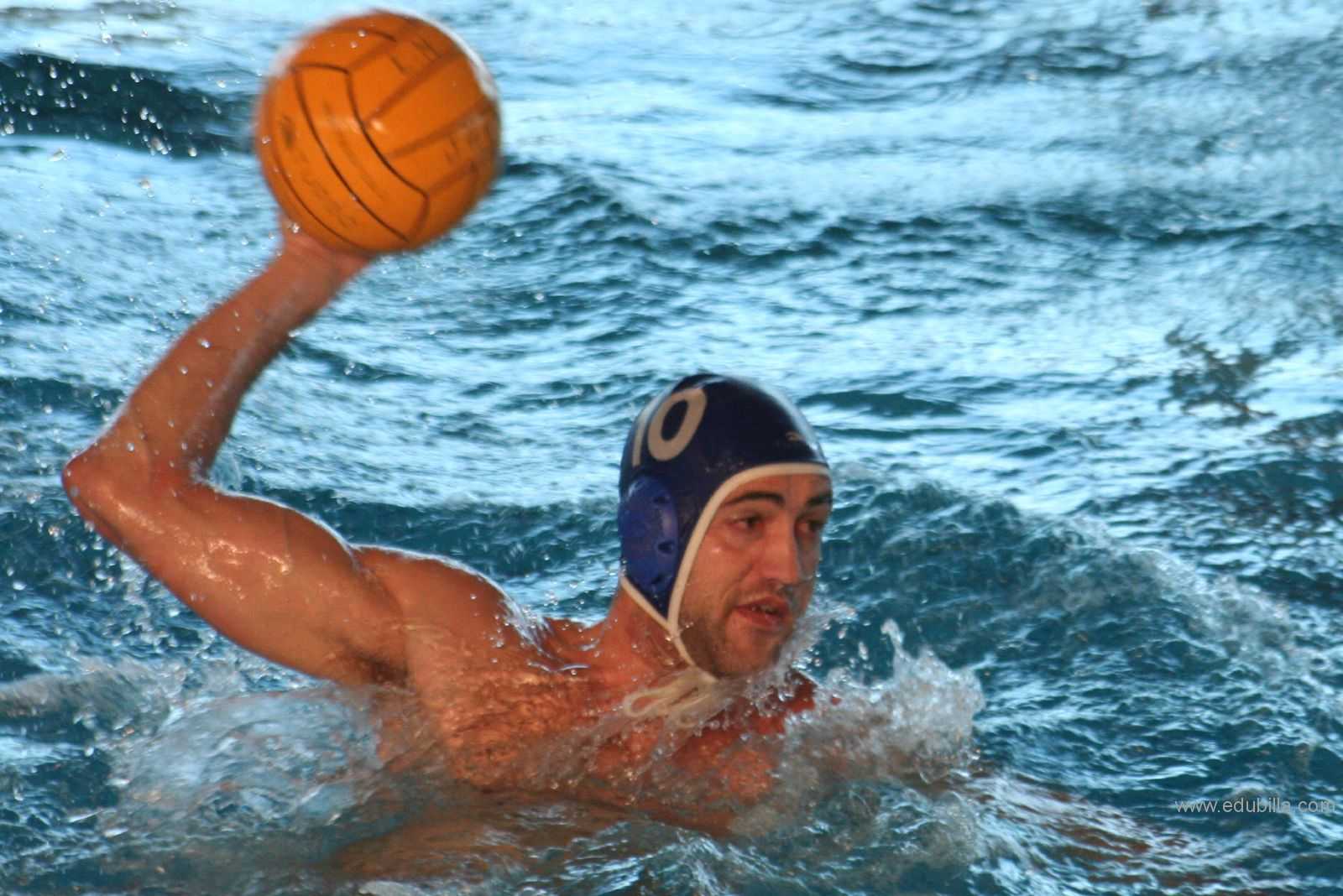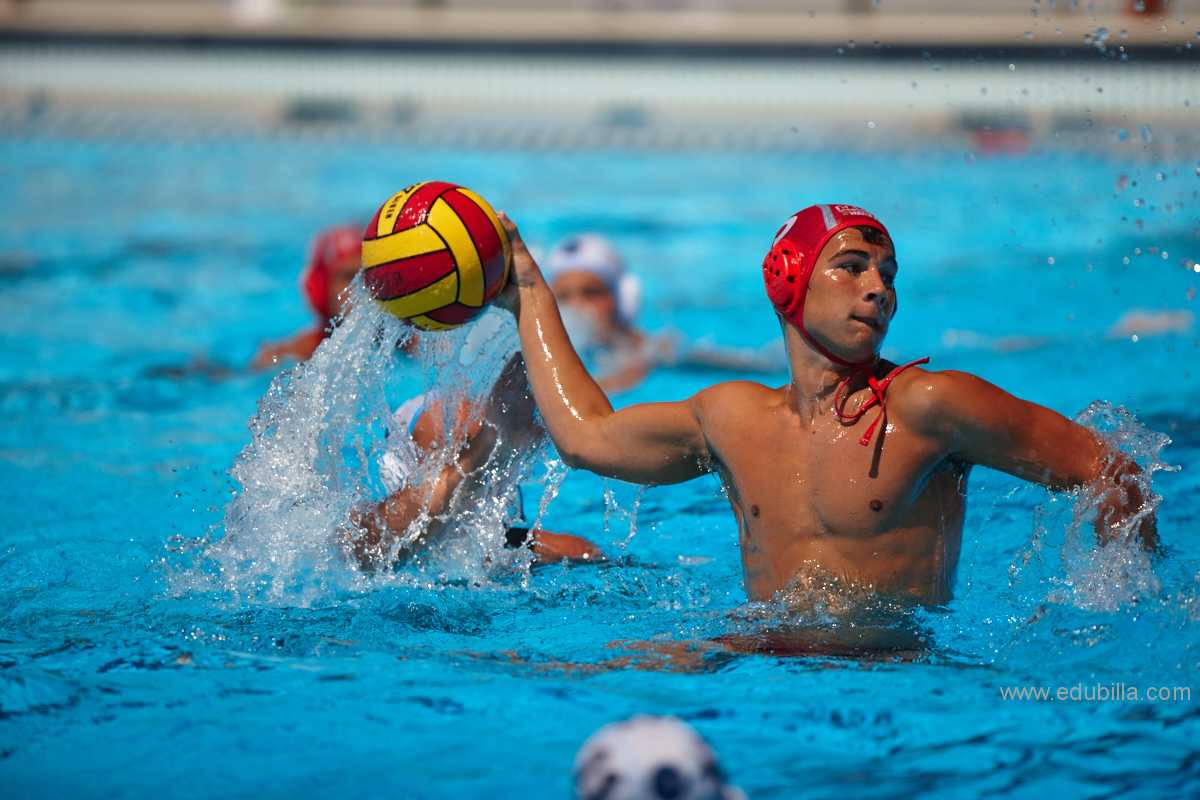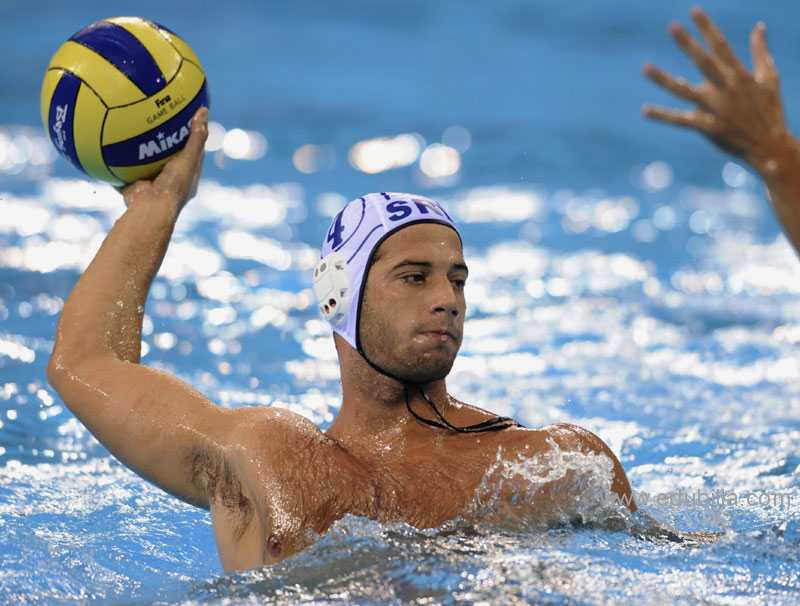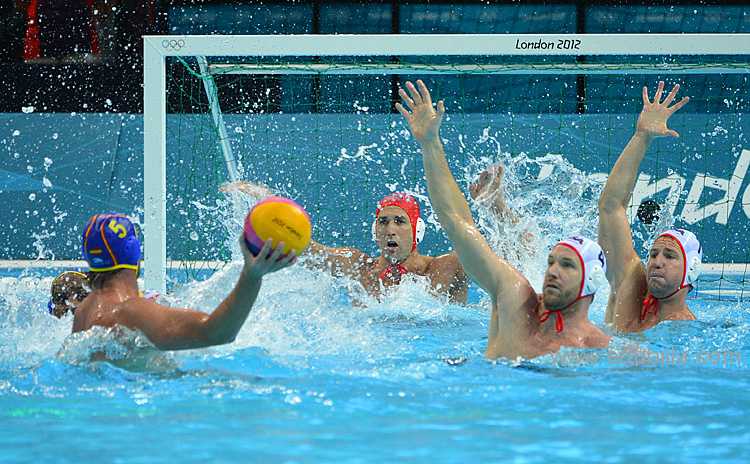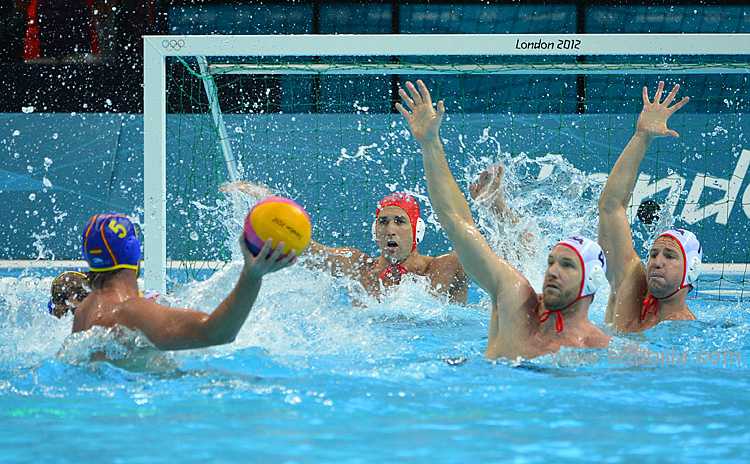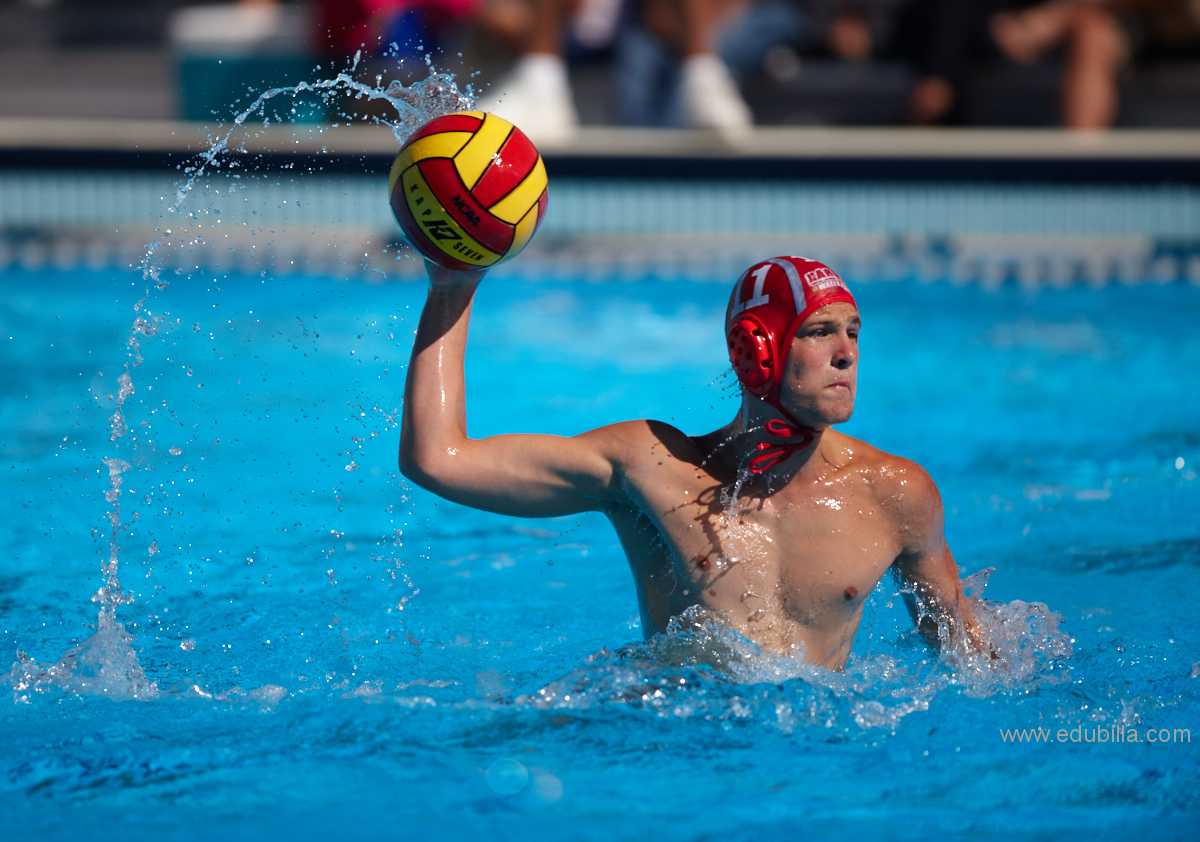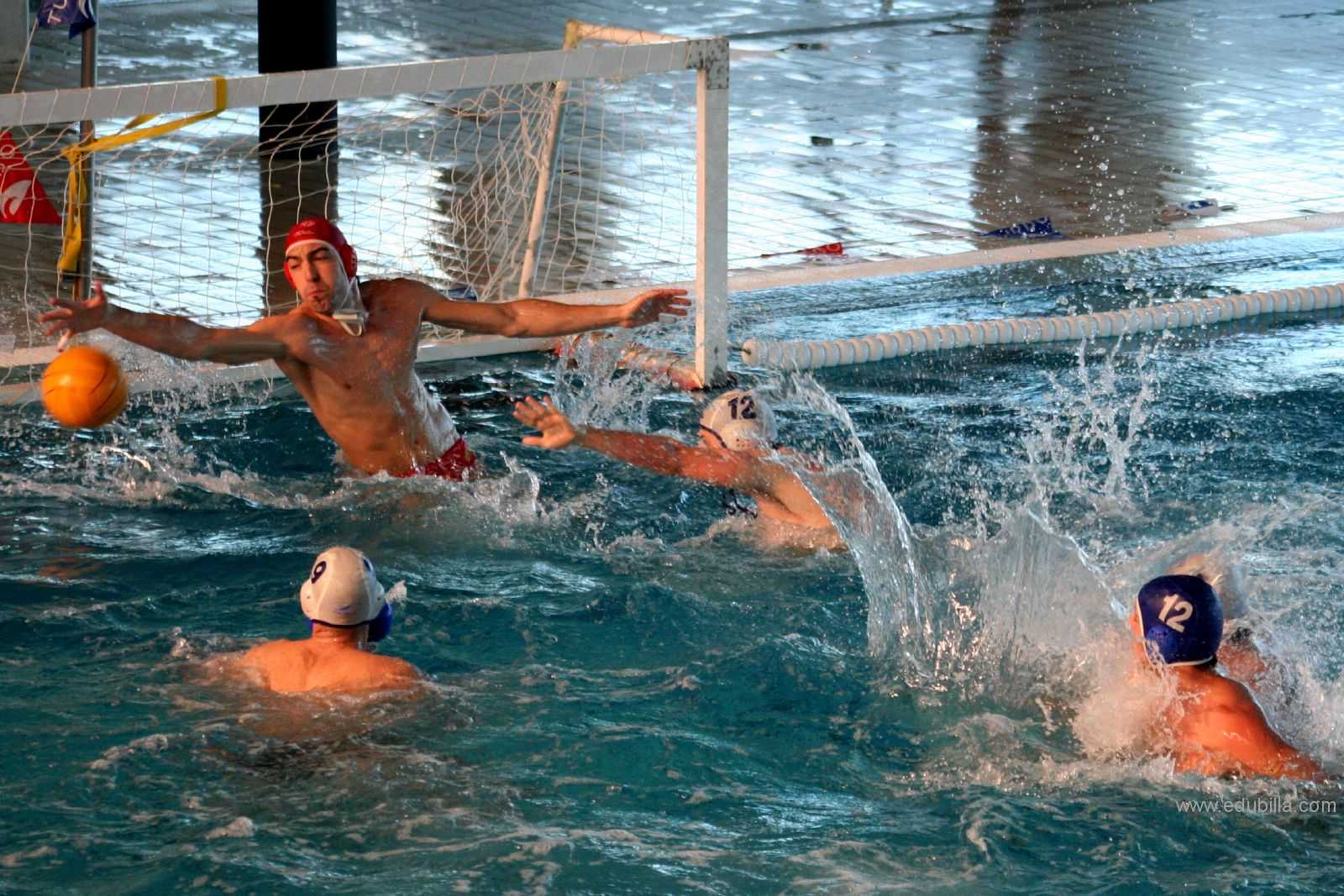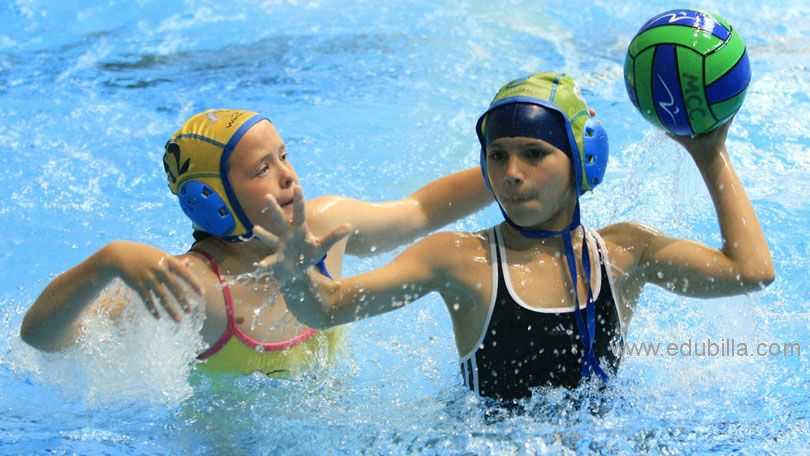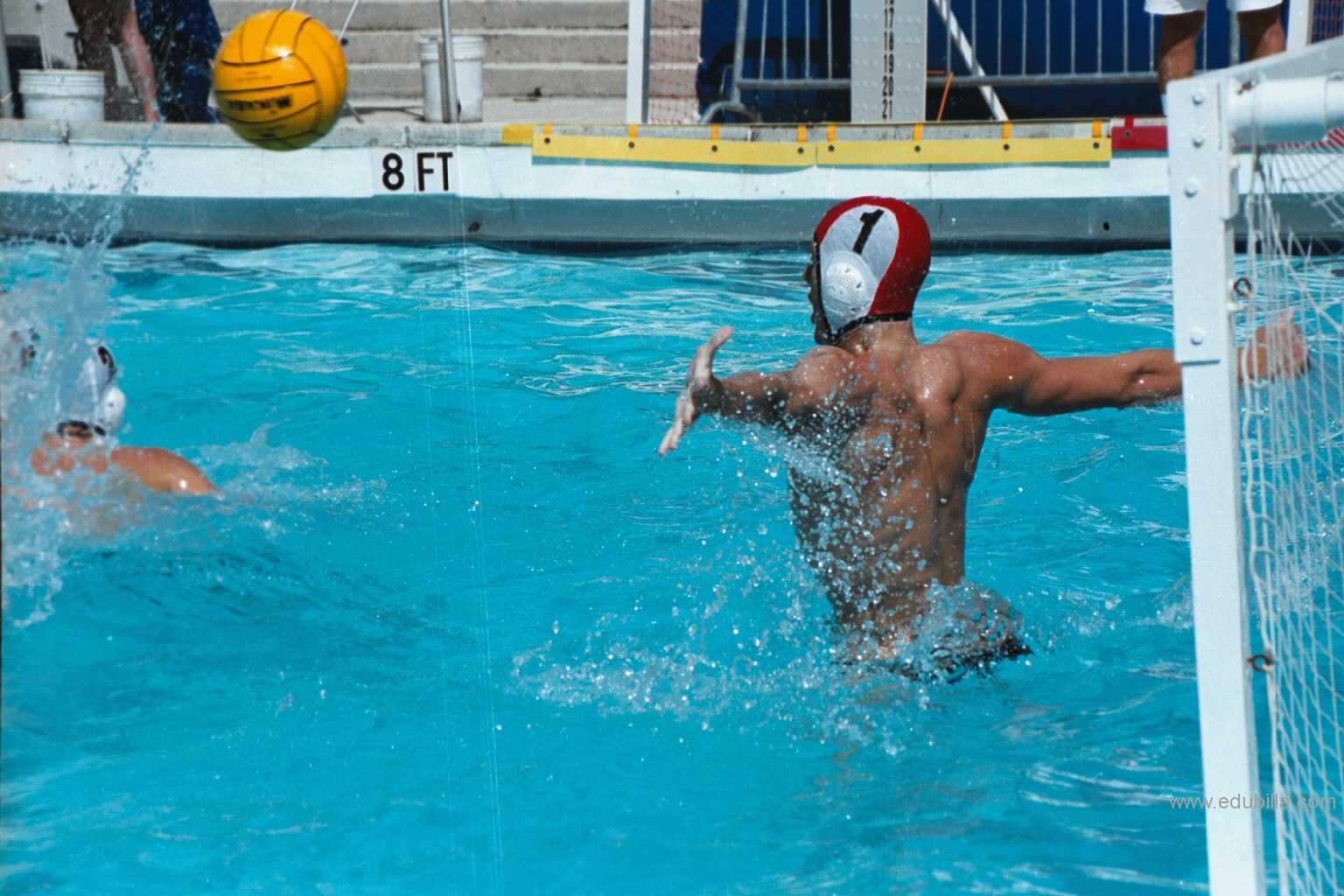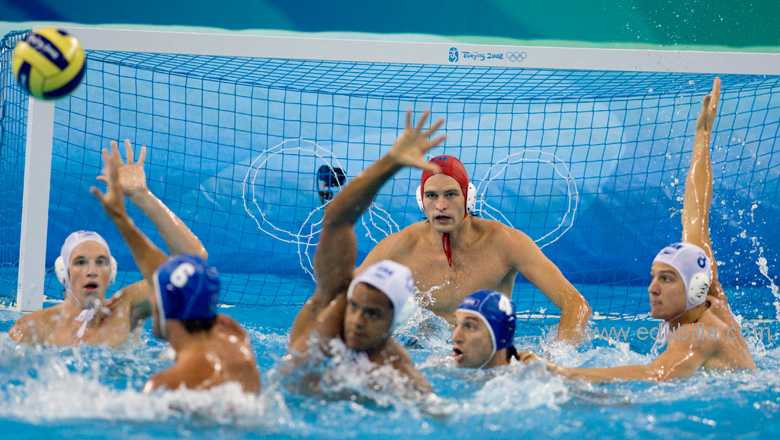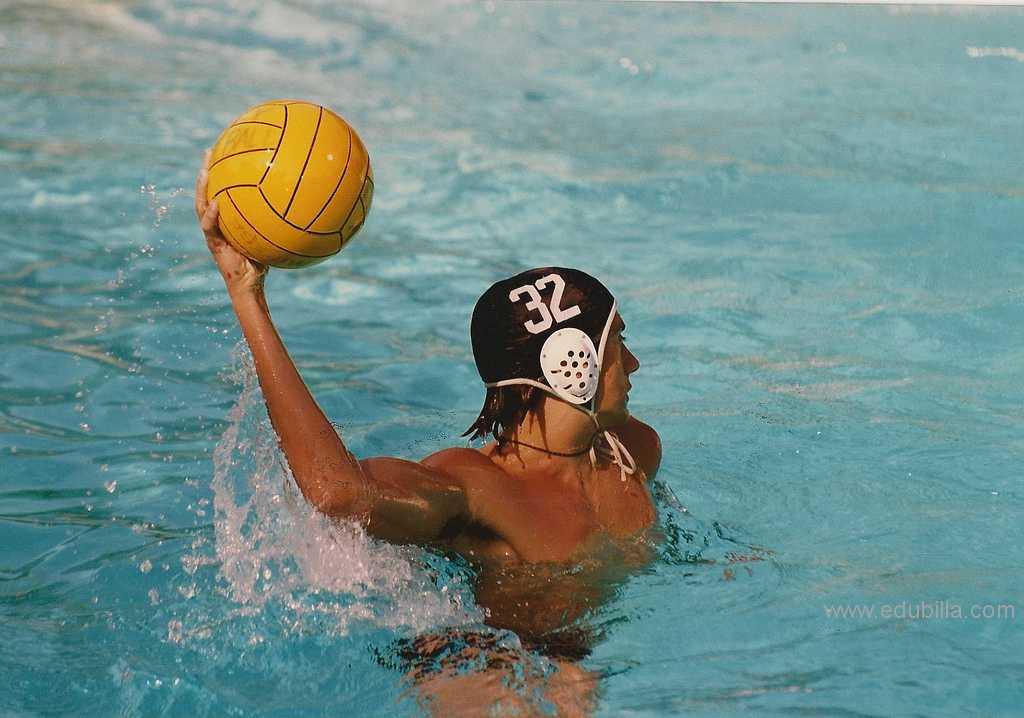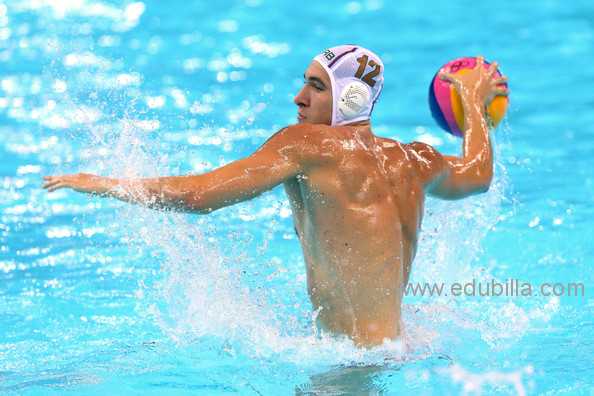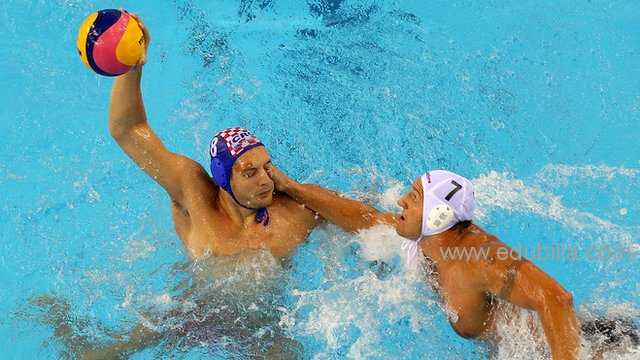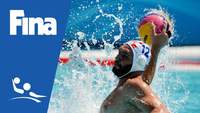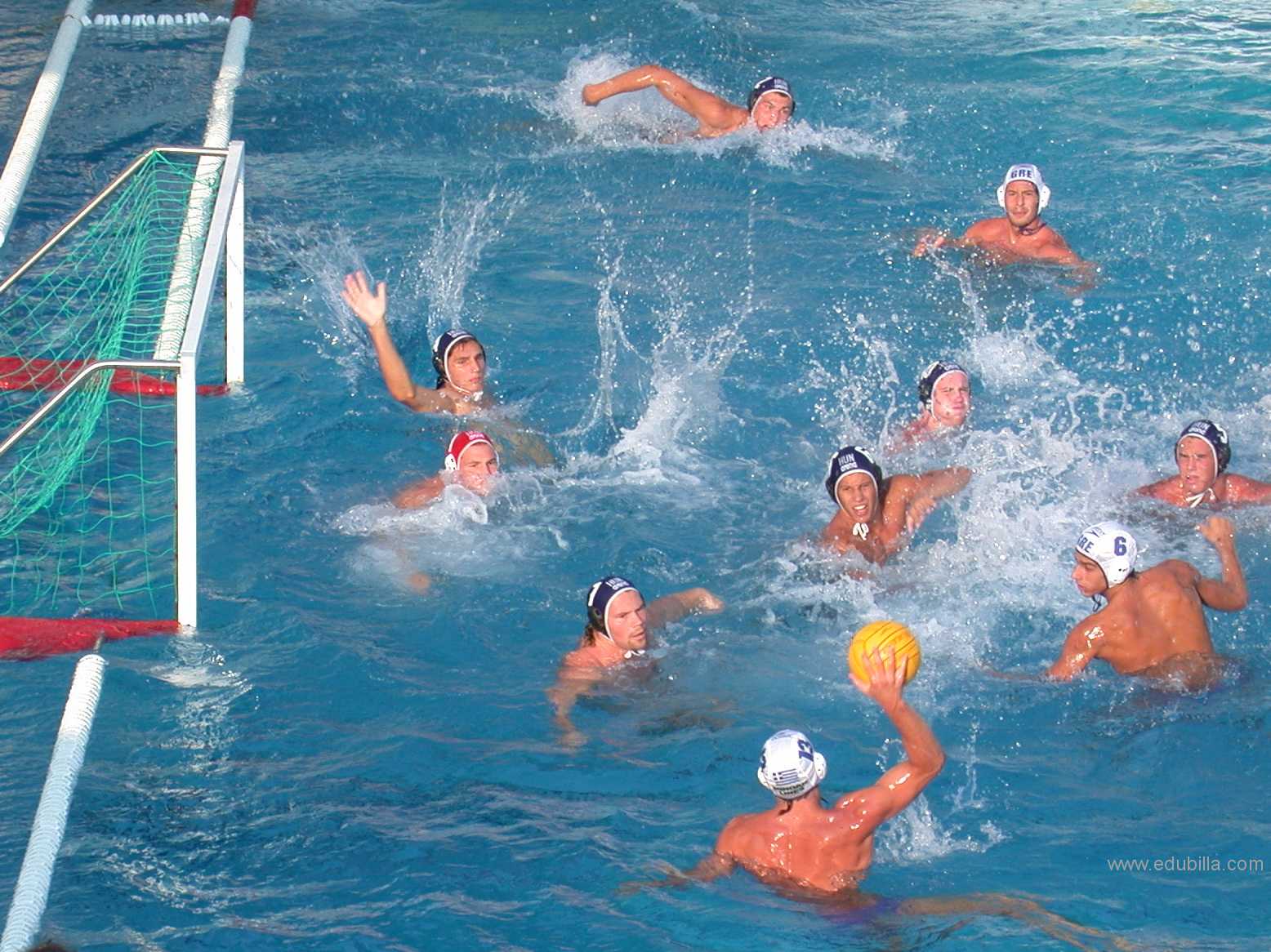
Overview Of Water polo
Water polo is a team water sport. The game consists of 4 quarters (or periods) in which the two teams attempt to score goals by throwing the ball into their opposition's goal, with the team that scores the most goals winning the game. A team consists of 6 field players and one goalkeeper in the water at any one time. In addition to this, teams may have substitute players (up to six under most governing bodies), including up to one substitute goalkeeper. Water polo is typically played in an all-deep pool (usually at least 1.8m deep), and players need considerable stamina and endurance to play the game.
Water polo is a very violent and aggressive sport. Minor fouls occur frequently and exclusion fouls (in which a player is suspended from the game for 20 seconds) are common.
Special equipment for water polo includes a water polo ball, which floats on the water; numbered and colored caps; and goals resembling a hockey goal in appearance, which either floats in the water or is attached to the side of the pool.
The game consists of swimming (with and without the ball), using a special form of treading water known as the eggbeater kick (to position a player upright in the water), throwing, catching, and shooting the ball using a single hand. Each team consists of 6 field players and a goalkeeper. Except for the goalkeeper, players participate in both offensive and defensive roles. The players are also required to have some ability to play in all offensive and defensive roles.
The game is thought to have originated in Scotland in the late 19th century as a sort of "water rugby". William Wilson is thought to have developed the game during a similar period. The game thus developed with the formation of the London Water Polo League and has since expanded, becoming widely popular in various places around the world, notably mainland Europe, the United States of America, China, Canada and Australia.
Game Rules
The rules of water polo are the rules and regulations which cover the play, procedure, equipment and officiating of water polo. These rules are similar throughout the world, although slight variations to the rules do occur regionally and depending on the governing body. Governing bodies of water polo include FINA, the international governing organisation for the rules; the NCAA rules, which govern the rules for collegiate matches in the USA; the NFHS rules which govern the rules in high schools in the USA and the IOC rules which govern the rules at Olympic events.
Number of players:
Seven players from each team (six field players and a goalkeeper) are allowed in the playing area of the pool during game play. Each team may also have five additional substitute players, and up to one of these players may take the position of the reserve goalkeeper. If a player commits a major foul, then that team will only have 6 players until the player is allowed to re-enter. If a player commits a brutality foul, then that team must play without that player, or any player taking his or her place, for 4 minutes.
Players may be substituted in and out after goals, during timeouts, at the beginning of each quarter, after ordinary fouls and after injuries. During game play, players enter and exit in the corner of the pool, or in front of their goal; when play is stopped, they may enter or exit anywhere.
If at any time during play a team has more players in the pool than they are allowed, a penalty is given to the opposing team.
Caps:
The two opposing teams must wear caps which contrast:
-with both (or either) goalkeeper cap color,
-with the other team's cap color and
-with the ball color.
In practice, one team usually wears blue caps and the other white, but some teams do choose to wear different cap colors. For instance, Australia's women's water polo team wears green caps.
Both goalies wear red caps. The first choice goalkeeper is usually marked "1" with the reserve being marked "13" (under FINA rules) or "1A" (under NCAA and NFHS rules).
Game and shot clock:
The game clock is stopped when the ball is not 'in play' (between a foul being committed and the free throw being taken, and between a goal being scored and the restart). As a result, the average quarter lasts around 12 minutes 'real time'. A team may not have possession of the ball for longer than 30 seconds without shooting for the goal unless an opponent commits an ejection foul. After 30 seconds, possession passes to the other team. However, if a team shoots the ball within the allotted time, and regains control of the ball, the shot clock is reset to 30 seconds.Each team may call 1 one-minute timeout in each period of regulation play, and one timeout if the game goes into overtime.During game play, only the team in possession of the ball may call a timeout.
Pool dimensions:
Dimensions of the water polo pool are not fixed and can vary between 20×10 and 30×20 meters. Minimum water depth must be least 1.8 meters (6 feet), but this in reality is sometimes not the case due to practicalities. The goals are 3 meters wide and 90 centimeters high. Water polo balls are generally yellow and of varying size and weight for juniors, women and men. The middle of the pool is designated by a white line. Before 2005, the pool was divided by 7 and 4 meter lines (distance out from the goal line). This has been merged into one 5 meter line since the 2005–2006 season. Along the side of the pool, the center area between the 5 meter lines is marked by a green line (if marked at all). The "five meters" line is where penalties are shot and it is designated by a yellow line. The "two meter" line is designated with a red line and no player of the attacking team can receive a ball inside this zone.
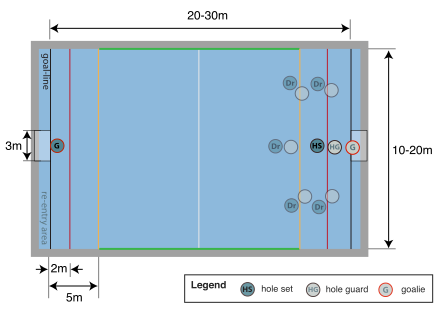
Detailed Water polo Rules Can Be Downloaded From Documents
Equipments Need For Water polo
Ball:
The ball weighs between 400g and 450g. The circumference of the ball is 0.68m to 0.71m for men and 0.65m to 0.67m for women.
Bathing caps:
Coloured bathing caps with individual numbers and ear protectors. Used to distinguish the various players on a team as well as to provide protection.
Lane ropes & buoys:
Used to distinguish the field of play and imaginary distances from the goals.
Goals:
Two goals, 3.0m wide and 0.9m high, float on the water.
Swimsuits:
The swimsuit should be non-transparent or with a separate undergarment.
History Of Water polo
The history of water polo as a team sport began in late 19th century England and Scotland, where water sports were a feature of county fairs and festivals.Men's water polo was the first team sport introduced at the modern Olympic games in 1900.
Development of the game:
Early Original Rules:
The rules of water polo were originally developed in the mid-nineteenth century in Great Britain by William Wilson. The modern game originated as a form of rugby football played in rivers and lakes in England and Scotland with a ball constructed of Indian rubber. This "water rugby" came to be called "water polo" based on the English pronunciation of the Balti word for ball, it means pulu. Early play allowed brute strength, wrestling and holding opposing players underwater to recover the ball; the goalie stood outside the playing area and defended the goal by jumping in on any opponent attempting to score by placing the ball on the deck.
Water polo changes in 1888:
By the 1880s, the game evolved that stressed swimming, passing, and scoring by shooting into a goal net; players could only be tackled when holding the ball and could not be taken under water. To deal with constant changes in rules, in 1888, the London Water Polo League was founded and approved rules to allow team competition, forming the foundation of the present game. The first English championships were played in 1888. In 1890, the first international water polo game was played; Scotland defeated England, 4–0.
Local rule variations:
In 2006, revisions were made to the NFHS 2006–2007 swimming/diving and water polo rulebook (USWP and NCAA rules still vary). The four and seven-meter lines were merged to a five-meter line. Under the revised rules, a goalkeeper may use two hands and stand on the bottom of the pool (if shallow) until the 5-meter line, and go beyond the 5-meter line according to the field rules (one hand on the ball no standing), but still not pass the half line. The goalie may strike the ball with a clenched fist, although this is not recommended.
New cap rules were also enacted. A goalie cap must now be in quarters alternating red/dark for home and red/white for away. The goalie must be number 1, 1a, or 1b. For women, a red swim cap must be worn under the goalie cap. A team's dark swim cap is no longer acceptable as it is hard to distinguish a goalie from field players if official cap is off.
Olympic competition:
Men's water polo at the Olympics was the among the first team sports introduced at the 1900 games (along with cricket, rugby, football (soccer), polo (with horses), rowing and tug of war).Women's water polo became an Olympic sport at the 2000 Sydney Olympic Games after political protests from the Australian women's team. Such protests were rewarded when Australia won the gold medal match against the United States with a "buzzer-beater" last-minute goal, taken from outside the seven-meter line.
Some of the best ever include Spain's Manuel Estiarte who played in a record six Olympics and led in scoring for four of them. Dezso Gyarmati of Hungary won water polo medals at five successive Olympic Games (gold 1952, 1956, 1964; silver 1948; bronze 1960), a record in water polo. Another major figure in the sport was Tamás Faragó,who led Hungary to Olympic Medals in 1972, 1976 and 1980. The play of American Terry Schroeder led the United States to its first Olympic silver medals in 1984 and 1988.
1956 Summer Olympics:
The most famous water polo match in history is probably the 1956 Summer Olympics semi-final match between Hungary and the Soviet Union. As the athletes left for the games, the Hungarian revolution began, and the Soviet army crushed the uprising. Many of the Hungarian athletes vowed never to return home, and felt their only means of fighting back was by victory in the pool. The confrontation was the most bloody and violent water polo game in history, in which the pool reputedly turned red from blood. The Hungarians defeated the Soviets 4–0 before the game was called off in the final minute to prevent angry Hungarians in the crowd reacting to Valentin Prokopov punching Ervin Zador's eye open. The Hungarians went on to win the Olympic gold medal by defeating Yugoslavia 2–1 in the final. Half of the Hungarian Olympic delegation defected after the games. A documentary by Lucy Liu, Freedom's Fury, premiered in April 2006, recounting the events of the 1956 Hungarian uprising and climaxing with this politicized game.
International play:
Every 2 to 4 years since 1973, a men's Water Polo World Championship is played together with the World Swimming Championship, under the auspices of FINA. Women's water polo was added in 1986. A second tournament series, the FINA Water Polo World Cup, has been held every other year since 1979. In 2002, FINA organized the sport's first international league, the FINA Water Polo World League, in which the best national teams compete against one another in an annual season format with nearly half a million dollar purse.
Internationally, the biggest water polo competition in the world is played in the Netherlands. Prince William of Wales was the captain of his collegiate water polo team at St Andrew's University, Scotland. The annual Varsity Match between Oxford and Cambridge Universities is the sport's longest running rivalry, first played in 1891.
Origin Of Water polo
Water Polo began as a sport sometime in the 19th century in England, although the early versions of the activity bear little resemblance to the modern day version played today.
Etymology:
The origins of water polo are obscure to say the least but we do know that the word "polo" is the English pronunciation of the Indian word "pulu," that means ball. Just as the ball game that is played on horseback became known as "polo," the ball game played in the water became known as "water polo," the name is the only connection between the sports.
First Played:
The game of water polo was first played in the United States in 1888. It featured the old rugby style of play which looked like American football in the water. "American style" water polo became very popular and by the late 1890's was played in such places as Madison Square Garden and Boston's Mechanics Hall, attracting 14,000 spectators to the big national championship games.
It is believed that British holiday resort owners invented this rather strange pastime during the mid-1800s, in an attempt to attract guests. The first games were played on nearby rivers and lakes, and the game's passing similarity to horseback polo gave it the name "water polo."
First Official Game:
The first official game was played in the Crystal Palace Plunge in London. Early games were generally exhibitions of brute strength. Passing, punting and dribbling were scarcely ever practiced. Each player had one goal in mind: to score goals, regardless of his position. A goal was scored when a player placed the ball, with two hands, on the deck (in the days before nets were introduced). A favourite trick among players was to place the ball, then five to nine inches in diameter, inside their swim suit, dive deep below the surface of what were often murky waters and then reappear as near to the goal as possible. Unfortunate was the player who surfaced too close to goal, however: in the days when the keeper was allowed to stand on the deck, the opportunist found himself pounced on by the goalie from a great height.
First American Polo Championships:
The first American polo championships took place on January 28, 1890 in Providence, where the Sydenham Swimming Club defeated the Boston Athletic Association 2-1. By the turn of the century, the game was one of the more popular spectator sports in America. Water polo spread to Hungary in 1889, Belgium in 1890, Austria and Germany in 1894 and France in 1895. The game was included in the Paris Olympic Games of 1900 as an exhibition. Only club teams participated and Great Britain’s Osborne Swimming Club, Manchester, defeated Belgium’s Swimming and Water Polo Club of Brussels 7-2 in the final game. Pupilles de Neptune de Lille, of France, took third place.
First Men’s Water Polo Development Trophy:
In 2007, the first men’s Water Polo Development Trophy was launched by FINA in Kuwait City, from May 2-8. The tournament, which included 12 teams normally not represented at the major FINA competitions, was won by Colombia, which defeated Puerto Rico in the final 16-4.
FINA Water Polo World Cup and World Championships:
World Championships have been held together with swimming, diving and synchronised swimming since 1973, when the inaugural event was held in Belgrade. The game was for men only until 1986, when the women’s tournament made its debut in Madrid.
A second tournament series, the FINA Water Polo World Cup, has been held every other year since 1979. In 2002, FINA organised the sport's first international league, the FINA Water Polo World League, in which the best national teams compete against one another in an annual season format with a purse of nearly half a million dollars (p28).
Governing Bodies
FINA:
International Swimming Federation(FINA) is the International Federation (IF) recognized by the International Olympic Committee (IOC) for administering international competition in Aquatics. It is one of several IFs which administer a given sport/discipline for the IOC and/or international community. It is based in Lausanne, Switzerland.
FINA currently oversees competition in five aquatics sports: swimming, diving, synchronized swimming, water polo and open water swimming. Beginning in 2013, high diving is an emerging discipline within FINA. FINA also oversees "Masters" competition (for adults) in its disciplines.
On July 24, 2009, Julio Maglione of Uruguay was elected FINA President.
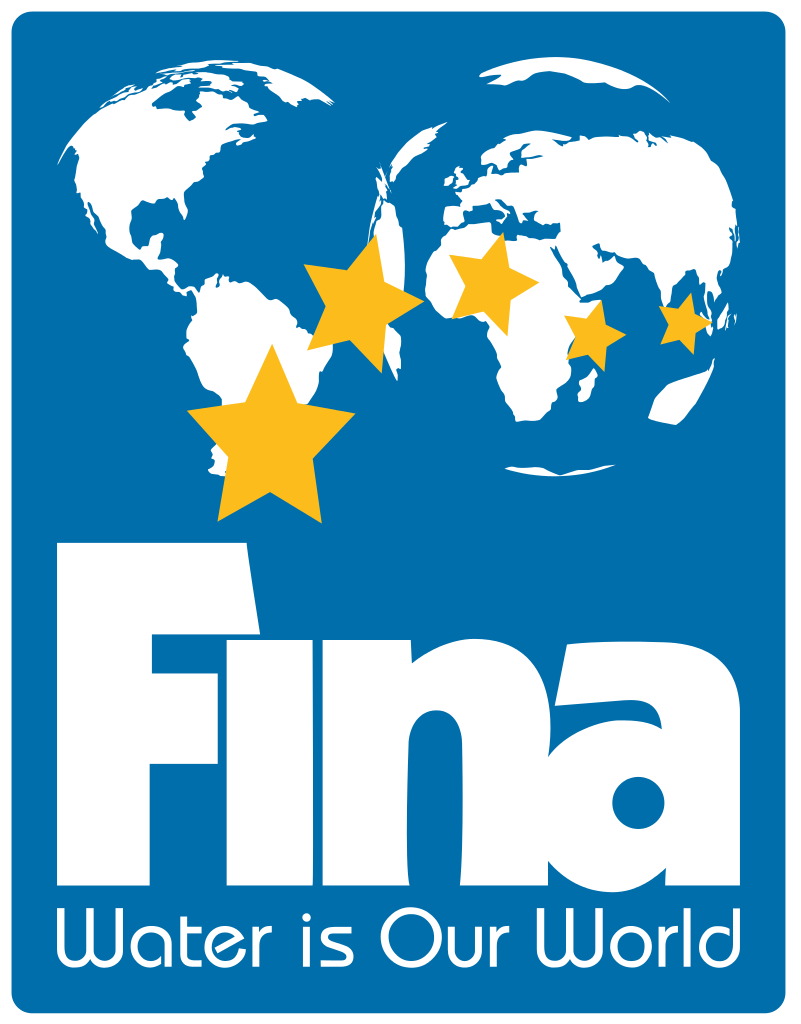
History:
FINA was founded on July 19, 1908 in the Manchester Hotel in London, UK at the end of the 1908 Summer Olympics by the Belgian, British, Danish, Finnish, French, German, Hungarian and Swedish Swimming Federations.
Number of national federations by year:
-1908: 8
-1928: 38
-1958: 75
-1978: 106
-1988: 109
-2000: 174
-2008: 197
-2010: 202
-2012: 203
Organization:
The FINA membership meets every four years, usually coinciding with the World Championships. There are two types of normal or "ordinary" congress: General and Technical. FINA’s highest authority is the General Congress. Any technical issues concerning FINA’s five aquatic disciplines are decided by the Technical Congress. Each Congress has two voting members from each Member federation, plus the following non-voting members: the 22 members of the Bureau, the Honorary Life President, and all Honorary Members. The Technical Congress has the following additional non-voting members: all members from the respective Technical Committees. "Extraordinary" Congress are also called from time to time, to deal with a specific topic or area of concern (e.g., an Extraordinary Congress was held with the 2009 World Championships to review the Masters swimming rules; there was a General Congress at the 2009 Worlds). All Congress meetings are chaired by FINA's president.
Events
FINA organizes one championship involving each of the five disciplines it oversees (the "World Championships"), as well championships and circuits in each of the disciplines.
World Championships:
The biggest FINA event is the biennial World Championships, currently held every odd year. It features competitions in all five aquatic disciplines. Prior to 2000, the event was held every 4 years, in the even year between (Summer) Olympic Games.
Discipline championships:
-Swimming: World Swimming Championships (25m), (aka "Short Course Worlds"). Bi-annual event (in even years), swum in 25-meter length pool (Olympic and World Championships are in a 50m pool).
-Water Polo: Water Polo World Leagues (men's and women's).
-Diving: Diving World Series
-Open Water: World Open Water Swimming Championships (aka "Open Water Worlds"). Even years from 2000-2010.
-Synchronized Swimming: Synchro World Cup.
-Masters: World Masters Championships (aka "Masters Worlds"). Bi-annual, in even years. "Masters" competition is for adults (20 years old and up). This championships features all 5 disciplines.
Other events:
In addition to the championships events listed above, FINA also organizes the following annual events, and sub-championships:
World Cups: in swimming, water polo (men's, women's), diving, high diving, open water (10Ks) and synchro.
Grand Prix: Annual race/competition series of multiple events in open water (races over 10-kilometers).
Junior Worlds: A world-level championships restricted to a younger age population (typically under-18, though can vary by discipline/gender). Held in swimming, water polo, diving, and synchronized swimming. Open Water is to begin in 2012.
World Men's Water Polo Development Trophy
To Visit FINA Click Here
Awards Related To Water polo
ACWPC All-Academic Awards:
The ACWPC All-Academic Award is the only one of its kind that recognizes athletes nationally and throughout all collegiate divisions. The recipients of these awards have not only been active in their water polo programs, but have maintained the highest level of academic focus and results. The All-Academic Award is presented to student-athletes who have excelled outside of the pool while maintaining their involvement in the pool.
Peter J. Cutino Award:
The Peter J. Cutino Award, named after former college water polo player and UC Berkeley coach Peter J. Cutino, is considered the most prestigious individual award in American collegiate water polo. It is given annually to the top male and female player in the National Collegiate Athletic Association (NCAA).
FINA Athletes of the Year:
The FINA Athletes of the Year, awarded by Fédération Internationale de Natation (FINA) and FINA Aquatics World Magazine, are a set of awards given in five categories: swimming, diving, synchronized swimming, water polo and open water swimming. The award was inaugurated in 2010 also in 2012 and 2013.
World Swimmers of the Year:
The Swimming World Magazine Swimmers of the Year, awarded by the American-based Swimming World Magazine. There are seven categories: World Swimmer, American Swimmer, European Swimmer, Pacific Rim Swimmer, World Disabled Swimmer, African Swimmer, and Open Water Swimmer of year. An award for male and female is made for each category.
The award was inaugurated in 1964, when Swimming World named Don Schollander as its World Swimmer of the Year. Two years later, a female category was added, and the awards continued in this format until 1980. The winners were mostly American until the rise of East Germany's women in the 1970s, and 1980 saw the creation of subcategories for American and European swimmers. Following the end of the Cold War, Germany declined following the end of the East's systematic state-sponsored doping program, while Australia's swimming team enjoyed a revival. In December 2013, Swimming World announced a decision to strip the drug-fueled East Germans of all World and European Swimmers of the Year awards.
-NCAA Men's Water Polo Championship
-NCAA Women's Water Polo Championship
-U.S. Intercollegiate Women's Water Polo Championship
Sample Documents Of Water polo
-Pele

